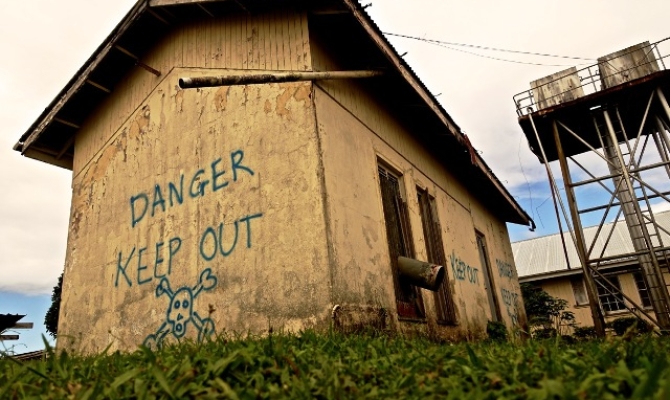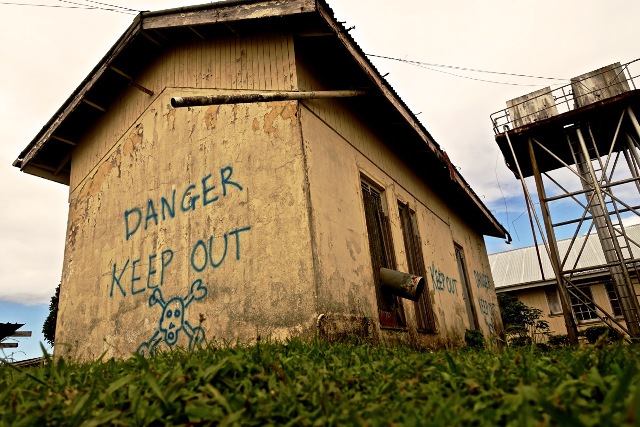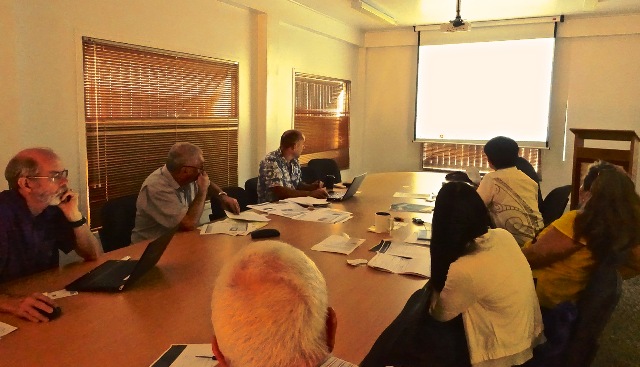
Waste Management and Pollution Control
Asbestos has been used for decades in a variety of building, plumbing, electrical, automotive and other applications due to its strength and heat resistant properties. However, unfortunately the inhalation of microscopic asbestos fibres can place individuals at risk of cancer and a variety of lung diseases. The European Union and Secretariat of the Pacific Regional Environment Programme (SPREP) have partnered since 2013 to address this Pacific hazardous waste issue through the PacWaste programme.
 Tamavua Hospital boiler room building, the site of the recent emergency asbestos removal.
Tamavua Hospital boiler room building, the site of the recent emergency asbestos removal.
Photo - Elizabeth Vanderburg
On the 21st and 22nd of May 2015, PacWaste held an asbestos Technical Advisory Panel meeting to prioritise the USD$2 million available for asbestos interventions aimed at removing asbestos containing materials and waste to minimise asbestos related diseases in 13 Pacific Island countries.
"The PacWaste project has now developed the most comprehensive picture we have ever had of the presence, condition and the threat asbestos poses to human health in 24 different islands in the Pacific" said the Mr Jesús Laviña, Head of Section for Natural Resources and Infrastructure at the European Union Delegation for the Pacific, Suva.
The Technical Advisory Panel meet in Suva to collate this information and use it to prioritise PacWaste asbestos management interventions in 28 schools, pre-schools, colleges and universities, 7 hospitals as well as 28 other public places, buildings and hazardous sites across the Pacific islands. By targeting works at these priority intervention sites, the project aims to protect communities most vulnerable to asbestos in Pacific islands through well planned asbestos removal, replacement and stabilisation works.
 Day 2 of the PacWaste Technical Advisory Panel meeting in Suva, Fiji
Day 2 of the PacWaste Technical Advisory Panel meeting in Suva, Fiji
Photo - Elizabeth Vanderburg
"This prioritisation of regional asbestos waste interventions is a critical milestone in the PacWaste project as it moves this project from the planning stage to the physical implementation phase in improving the management of hazardous waste across the Pacific" said Mr David Sheppard, Director General of SPREP.
"Targeting priority infrastructure works, training of waste-workers, improved waste management systems and waste recycling programmes, particularly in the areas of asbestos through the PacWaste programme, will all reduce the threat of this dangerous substance to Pacific island communities".
Further action will still be needed to manage all of the Pacific island's asbestos legacies of the past. PacWaste has estimated that over 700,000 square metres of asbestos still remain in the region and will require over USD$113 million expenditure to remove it from the 24 surveyed islands found at risk by the PacWaste programme.
Dr. Rokho Kim, an Environmental Health Specialist from the World Health Organization (WHO), who also joined the PacWaste asbestos meeting, advised that "Pacific Island nations should consider supporting international efforts to eliminate asbestos-related diseases" and should also "Consider enacting national asbestos control policy to minimise the entry of new asbestos sources into their countries while projects such as PacWaste are battling to eliminate asbestos from older sources".
Fifty-five countries in the world have now banned asbestos mining and the production of goods containing them, including Australia and New Caledonia, while New Zealand is currently enacting ban legislation after reviewing the threat from 'new' asbestos sources.
 Tamavua Hospital boiler room building, the site of the recent emergency asbestos removal.
Tamavua Hospital boiler room building, the site of the recent emergency asbestos removal. Photo - Elizabeth Vanderburg
On the 21st and 22nd of May 2015, PacWaste held an asbestos Technical Advisory Panel meeting to prioritise the USD$2 million available for asbestos interventions aimed at removing asbestos containing materials and waste to minimise asbestos related diseases in 13 Pacific Island countries.
"The PacWaste project has now developed the most comprehensive picture we have ever had of the presence, condition and the threat asbestos poses to human health in 24 different islands in the Pacific" said the Mr Jesús Laviña, Head of Section for Natural Resources and Infrastructure at the European Union Delegation for the Pacific, Suva.
The Technical Advisory Panel meet in Suva to collate this information and use it to prioritise PacWaste asbestos management interventions in 28 schools, pre-schools, colleges and universities, 7 hospitals as well as 28 other public places, buildings and hazardous sites across the Pacific islands. By targeting works at these priority intervention sites, the project aims to protect communities most vulnerable to asbestos in Pacific islands through well planned asbestos removal, replacement and stabilisation works.
 Day 2 of the PacWaste Technical Advisory Panel meeting in Suva, Fiji
Day 2 of the PacWaste Technical Advisory Panel meeting in Suva, FijiPhoto - Elizabeth Vanderburg
"This prioritisation of regional asbestos waste interventions is a critical milestone in the PacWaste project as it moves this project from the planning stage to the physical implementation phase in improving the management of hazardous waste across the Pacific" said Mr David Sheppard, Director General of SPREP.
"Targeting priority infrastructure works, training of waste-workers, improved waste management systems and waste recycling programmes, particularly in the areas of asbestos through the PacWaste programme, will all reduce the threat of this dangerous substance to Pacific island communities".
Further action will still be needed to manage all of the Pacific island's asbestos legacies of the past. PacWaste has estimated that over 700,000 square metres of asbestos still remain in the region and will require over USD$113 million expenditure to remove it from the 24 surveyed islands found at risk by the PacWaste programme.
Dr. Rokho Kim, an Environmental Health Specialist from the World Health Organization (WHO), who also joined the PacWaste asbestos meeting, advised that "Pacific Island nations should consider supporting international efforts to eliminate asbestos-related diseases" and should also "Consider enacting national asbestos control policy to minimise the entry of new asbestos sources into their countries while projects such as PacWaste are battling to eliminate asbestos from older sources".
Fifty-five countries in the world have now banned asbestos mining and the production of goods containing them, including Australia and New Caledonia, while New Zealand is currently enacting ban legislation after reviewing the threat from 'new' asbestos sources.